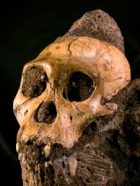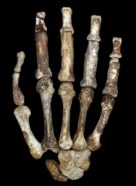Old bones ignite fresh debate
Scientists try to understand how 2 million-year-old fossils fit among ancient species
Scientists recently discovered two sets of 2 million-year-old fossils in a cave in South Africa. The bones might belong to an early ancestor of modern humans. Or, they might not. It depends whom you ask.

Berger’s team recently published new studies of the fossils, which include an adult female and a young male. The researchers say the creatures resemble both an ancient apelike species and a species that might have led to early Homo species. Homo is the genus, or category, of animals that includes humans and humanlike species. Modern humans, or Homo sapiens, are the only Homo species alive today.
About 2.5 million years ago, an upright-walking, apelike species evolved into the earliest members of the Homo genus. When a species evolves, it changes very slowly over a very long period of time. Scientists have long been interested in finding evidence of the species that descended from an apelike species and later evolved into something more humanlike. Berger’s fossil discovery might fit the bill for such a creature. He named the new species Australopithecus sediba, or A. sediba for short.
But many scientists challenge the human link. Anthropologist Brian Richmond of George Washington University in Washington, D.C., told Science News that some Homo fossils are older than 2 million years. He suspects the newly discovered species is too young to be their ancestor.

However, scientists studying the South African fossils say the evidence is there. One team studied three-dimensional computer models that helped show what the brain of the ancient species looked like. The team’s data indicate the frontal part of that brain resembles the human brain more than that of ancient, apelike creatures. The organization of this part of the brain, they argue, was crucial for the evolution from apelike species to human ancestors.
However, another scientist says a computer representation of A. sediba’s brain surface shows some marks that look more apelike than humanlike. Still, Dean Falk, an anthropologist at Florida State University in Tallahassee, hasn’t ruled out the arguments by Berger’s team.
“I am receptive to the team’s hypothesis that their A. sediba specimens may represent late-surviving members of the lineage that gave direct rise to early Homo,” she told Science News. Falk was not involved in the new studies.
Other researchers studied the shape of the fossilized pelvis in the newfound species. It resembles a bowl — just as the human pelvis does. In addition, bones from the feet, legs and ankles suggest that A. sediba walked upright on two legs. Studies of hands from the skeletons showed that the species had shortened fingers and a longer thumb, important features of human hands.
Scientists will continue to debate the A. sediba fossils as they try to understand how modern humans evolved from ancient species. The fossils were found in a region near Johannesburg called the Cradle of Humankind. Many ancient bones discovered there have been used to help scientists learn more about the ancestors of modern humans.







